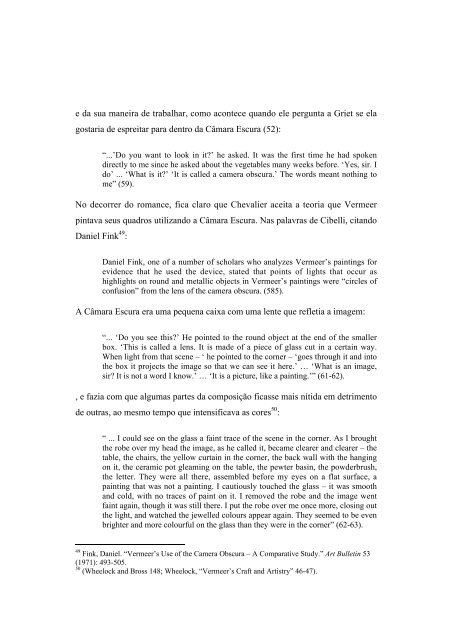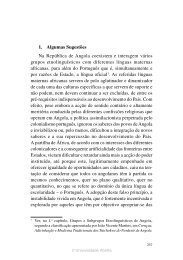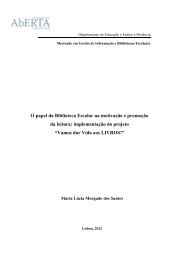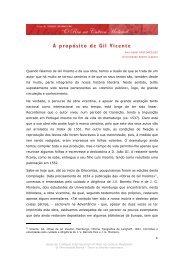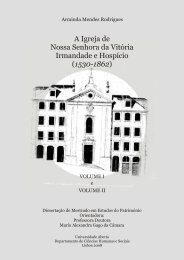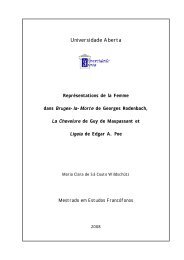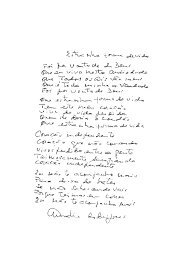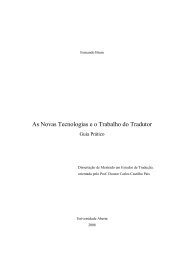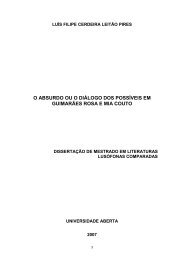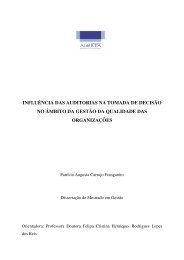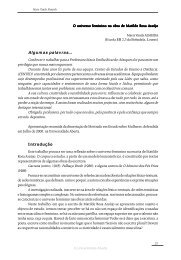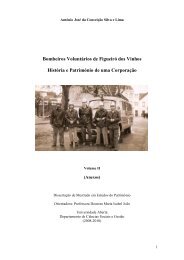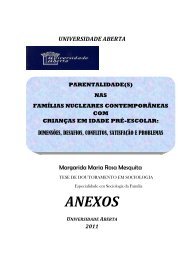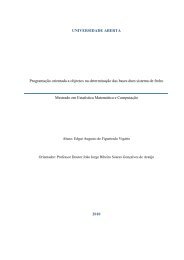Diálogos Transdisciplinares em Girl with a Pearl Earring: a Arte ...
Diálogos Transdisciplinares em Girl with a Pearl Earring: a Arte ...
Diálogos Transdisciplinares em Girl with a Pearl Earring: a Arte ...
Create successful ePaper yourself
Turn your PDF publications into a flip-book with our unique Google optimized e-Paper software.
e da sua maneira de trabalhar, como acontece quando ele pergunta a Griet se ela<br />
gostaria de espreitar para dentro da Câmara Escura (52):<br />
“...’Do you want to look in it?’ he asked. It was the first time he had spoken<br />
directly to me since he asked about the vegetables many weeks before. ‘Yes, sir. I<br />
do’ ... ‘What is it?’ ‘It is called a camera obscura.’ The words meant nothing to<br />
me” (59).<br />
No decorrer do romance, fica claro que Chevalier aceita a teoria que Vermeer<br />
pintava seus quadros utilizando a Câmara Escura. Nas palavras de Cibelli, citando<br />
Daniel Fink 49 :<br />
Daniel Fink, one of a number of scholars who analyzes Vermeer’s paintings for<br />
evidence that he used the device, stated that points of lights that occur as<br />
highlights on round and metallic objects in Vermeer’s paintings were “circles of<br />
confusion” from the lens of the camera obscura. (585).<br />
A Câmara Escura era uma pequena caixa com uma lente que refletia a imag<strong>em</strong>:<br />
“... ‘Do you see this?’ He pointed to the round object at the end of the smaller<br />
box. ‘This is called a lens. It is made of a piece of glass cut in a certain way.<br />
When light from that scene – ‘ he pointed to the corner – ‘goes through it and into<br />
the box it projects the image so that we can see it here.’ … ‘What is an image,<br />
sir? It is not a word I know.’ … ‘It is a picture, like a painting.’” (61-62).<br />
, e fazia com que algumas partes da composição ficasse mais nítida <strong>em</strong> detrimento<br />
de outras, ao mesmo t<strong>em</strong>po que intensificava as cores 50 :<br />
“ ... I could see on the glass a faint trace of the scene in the corner. As I brought<br />
the robe over my head the image, as he called it, became clearer and clearer – the<br />
table, the chairs, the yellow curtain in the corner, the back wall <strong>with</strong> the hanging<br />
on it, the ceramic pot gleaming on the table, the pewter basin, the powderbrush,<br />
the letter. They were all there, ass<strong>em</strong>bled before my eyes on a flat surface, a<br />
painting that was not a painting. I cautiously touched the glass – it was smooth<br />
and cold, <strong>with</strong> no traces of paint on it. I r<strong>em</strong>oved the robe and the image went<br />
faint again, though it was still there. I put the robe over me once more, closing out<br />
the light, and watched the jewelled colours appear again. They se<strong>em</strong>ed to be even<br />
brighter and more colourful on the glass than they were in the corner” (62-63).<br />
49<br />
Fink, Daniel. “Vermeer’s Use of the Camera Obscura – A Comparative Study.” Art Bulletin 53<br />
(1971): 493-505.<br />
50<br />
(Wheelock and Bross 148; Wheelock, “Vermeer’s Craft and Artistry” 46-47).


